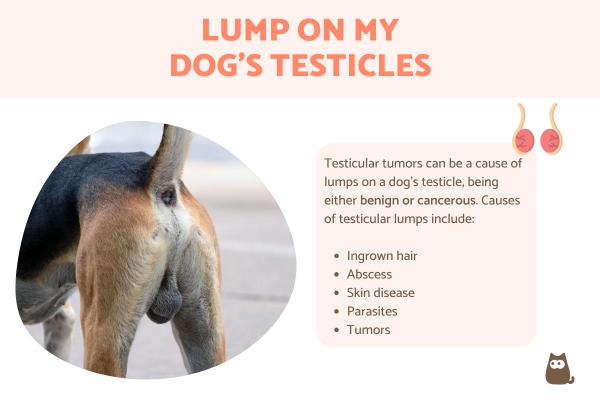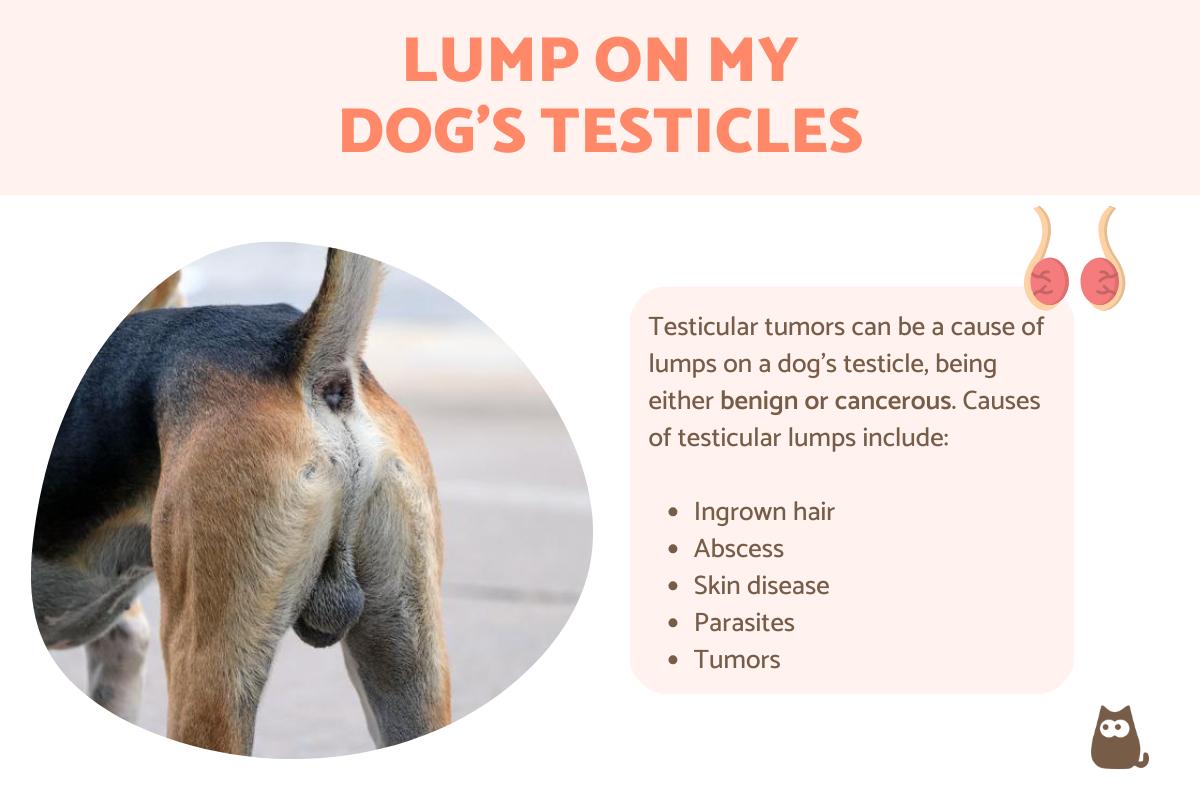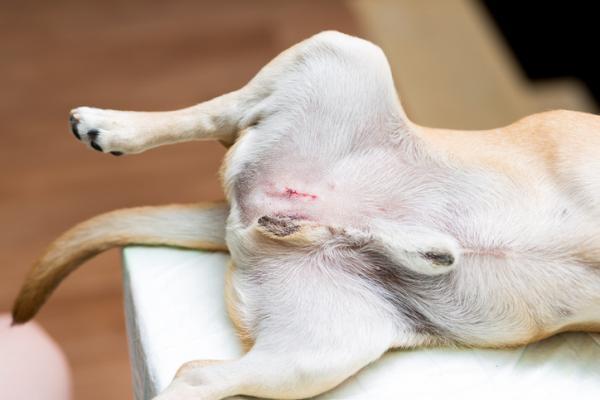Lump on My Dog's Testicle Causes



See files for Dogs
Orchitis in dogs refers to inflammation of the dog's testicle. This can be a result of various processes, but it is possible you can feel the presence of a small lump. Testicular tumors in dogs are are one of the most common in senior dogs over the age of 10 years. Although the location of a dog's testicles means we can often see changes more easily, a lump or growth is not usually observed until the dog undergoes an examination by their veterinarian. For this reason, it is important to be alert to any other related symptoms which we may observe before noticing a lump on our dog's testicles.
If there is a lump on your dog's testicle, AnimalWised informs you on the possible causes of this inflammation or growth. We also discuss the available options in terms of treatment, especially if the lump is a testicular tumor.
Why is there a lump on my dog's testicle?
As we stated above, if your dog has a lump on their testicles, it has most likely been discovered by a veterinarian. After the discovery, they will perform the necessary tests to reach a diagnosis. They should also alert you to the possible results of these tests, especially if there is a potentially fatal disease such as testicular cancer in dogs.
When an anomalous growth on a dog's testicle has been discovered, it could be one of these possible reasons:
- Ingrown hair: when the hair grows back into the skin, often resulting in an infection. This can cause a small lump on the dog's testicle which will usually resolve itself on its own. An ingrown hair can be exacerbated by poor hygiene since bacteria in the skin can lead to an abscess.
- Abscess: while an ingrown hair may be the cause of an abscess, it could also be a result of traumatic injuries to the testicle or even parasitical infections. For example, running over dry shrubbery can lead to a cut which then gets infected. The dog's abscess should usually heal on its own, but if the infection becomes acute, antibiotic treatment will be required.
- Skin disease: it is more common for skin diseases in dogs to result in rash-like symptoms. If the skin disease results in inflammation, it is possible small lumps will emerge. These can be treated with topical medications or by addressing the underlying cause of the disease, depending on diagnosis.
- Parasite: it is possible some parasites will burrow into the skin of the testicle and result in a lump. This could also be due to laying eggs in the skin, as is the case with botflies. Deworming treatment for dogs or extraction of the parasite are common forms of treatment.
- Tumor: a tumor is another word for neoplasm, typified as an abnormal growth of cells. We detail these types of testicular lumps in the following sections.
It is important to note that a dog's testicle may also swell for reasons other than testicular tumors. The general term for testicular inflammation is known as orchitis in dogs. Such swelling doesn't necessarily mean there is a neoplasm or tumor. In these cases, the testicle itself has become inflamed, rather than a growth has developed on the testicle. To learn more, our article on why a dog has swollen testicles can explain further.
What is a testicular tumor in dogs?
There are different types of canine testicular tumors. They are typically classified by the type of cells which cause the growth. Not all testicular tumors are malignant, but it is possible for the lump to be malignant. This means it is a result of a cancerous process. 5 to 15% of cancerous tumors in dogs are believed to be testicular. They are much less common in cats.
While breeds such as the Boxer, Chihuahua, Pomeranian and German Shepherd are thought to be prone to testicular cancers, it is a fairly indiscriminate disease. Age is a significant factor and older dogs are more likely to develop malignant testicular tumors. The most common types of testicular neoplasia are:
- Sertoli cell tumor: the most frequent testicular tumor in dogs (40-50%) and one of the easiest to diagnose because it tends to grow larger than those that affect other cells. Sertoli cells are involved in the sperm maturation process, with sperm production affected when these tumors develop.
- Leydig cell tumor: they usually appear with an incidence of approximately 25% and do not grow too large. This may be the cause of a small lump on a dog's testicle. Leydig cells are involved in the production of the hormone testosterone.
- Seminoma: this is a tumor that grows in the seminiferous tubules, the site of germination for sperm cells. It has an incidence of approximately 31% and bears certain similarities with Sertoli cell tumors when observed with the naked eye.
The incidence of each of these canine testicular tumors is relatively slim. In some cases it is effectively insignificant. It should also be noted that some patients may have several types of testicular tumor at the same time. Having one type of testicular tumor does not prevent the future growth of another. Our article on skin tumors in dogs can let us know more about these types of canine tumor.

Symptoms of canine testicular tumors
When you find a lump on your dog's testicle, it is normal to worry about the possible effects on their health. Dogs with testicular tumors do not only have impediment to their reproductive system. The testes are endocrine glands. When alterations occur, endocrinological issues can cause signs and symptoms in other bodily systems. These effects can include:
- Scrotal and/or testicular enlargement: regardless of the type of tumor which is diagnosed, a change in size will be evident on one or both testicles. If the testes enlarge, so too will the scrotal sac.
- Blood in the urine: testicular tumors often result in lesions in the prostate, causing blood to appear in the dog's urine. This may simply change the tone of the urine to a darker color as the blood mixes into the urine stream. We may also observe difficulty in the ability to urinate. Learn more with our related article on prostate cancer in dogs.
- Pain: while it depends on the growth of the tumor, if it manages to affect a nerve, the animal will suffer pain and its quality of life will decrease.
- Lack of appetite: if testicular cancer in a dog progresses without intervention, serious consequences can occur. Inappetence usually occurs as a secondary symptom due to the pain and energy depletion the animal may experience.
- Perineal hernias: some testicular tumors are related to the appearance of perineal hernias. However, a perineal hernia in dogs does not necessarily mean the dog is suffering from a tumor or cancer. This is why physical examination is so important.
- Feminization syndrome: this is a set of characteristic signs that occur in some testicular tumors (generally those caused by sertoli cell proliferation). These tumors usually cause endocrinological problems which trigger feminization syndrome. The results include poor hair quality, alopecia, pendulous foreskin and even attraction to other males. There is an increased risk of this syndrome in dogs with cryptorchidism, i.e. undescended testicles[1].
To help you find out if your dog is suffering from any discomfort, we recommend taking a look at this other article on 30 signs your dog is sick.
Causes of canine testicular tumors
As in most types of canine tumor, the causes of testicular tumors in dogs are often nonspecific or sometimes even idiopathic (unknown). However, the following causes of testicular tumors in dogs have been shown in related research studies:
- Hormonal disorders: it has been shown that some hormonal disorders can result in testicular tumors, especially when there are problems with estrogen production.
- Cryptorchidism: to a lesser extent, but no less important. Cryptorchidism is seen to be a possible triggering factor for testicular tumor. This could happen when either one or both of the dog's testes have not yet descended.
In the majority of cases, we will not be able to determine the cause of the tumor, regardless if it was determined to be a type of canine cancer. The reason is that determining the cause is time consuming, costly and unnecessary to provide the correct treatment.
Diagnosis of testicular tumors in dogs
The first suspicion of testicular cancer in dogs usually appears with physical examination. However, it is possible you will have seen other symptoms such as urinating blood or any of the others listed in the above sections.
When a veterinarian suspects testicular tumors, they will likely have felt a small lump or lumps in the testicles by palpitating the area with their fingers. To achieve a confirmed diagnosis, the veterinarian will have to carry out further tests to rule out other pathologies. These include lumps on the testicle visible to the naked eye such as:
- Twisting of the spermatic cord
- Physical trauma the testicle
- Spermatocele (a type of benign cyst)
- Scrotal hernia
- Scrotal abscess
The veterinary practitioner should rely on complementary tests such as ultrasound and biopsy, both to confirm the diagnosis of testicular tumor and to know what type of cell is affected (a cytology or blood test may also be indicated). With all the data assessed and being absolutely sure of what it is, the veterinarian will proceed with treatment. These diagnostic tests will be able to tell us if the dog has testicular cancer and whether it has metastasized.
Treatment of testicular tumors in dogs
The main treatment for all types of testicular cancers in dogs is surgical removal. In cases where a single testicle is affected, it is possible to remove only the one testicle. However, complete castration is almost always recommend to avoid a recurrence in the other testicle. In addition to surgical removal, effective pain management will be required to ensure the comfort of the dog.
In the cases where a cancer has metastasized to another part of the body, treatment will depend on the severity and location. In some cases, it may be possible to treat the cancer with chemotherapy for dogs, but this will depend on the individual circumstances.
As with most diseases, prevention is better than cure. AnimalWised recommends the sterilization of all dogs, male and female. There are too many dogs being abandoned which need rehoused. We promote an ‘adopt don't shop’ approach to caring for dogs. Castration in males also prevents physical and behavioral problems later in a dog's development. Read about what to expect after your dog is neutered to learn more.

Prognosis of testicular tumor in dogs
Testicular tumors are usually benign. The literature is contradictory when it comes to the incidence of metastasis (i.e. spreading to other parts of the body) in this type of pathology. After castration, it is common for the dog to return to a normal quality of life before they had the tumor. The prognosis will depend on early detecting, underlying conditions and the extent of the pathology's progress.
You may also want to know how to prevent testicular cancer in dogs. Successful complete castration is 100% effective in preventing testicular cancer and other testicular tumors in dogs. It also provides other important health benefits to the canine, as specified above.

This article is purely informative. AnimalWised does not have the authority to prescribe any veterinary treatment or create a diagnosis. We invite you to take your pet to the veterinarian if they are suffering from any condition or pain.
If you want to read similar articles to Lump on My Dog's Testicle Causes, we recommend you visit our Reproductive system diseases category.
1. Quartuccio, M., et al. (2012). Sertoli cell tumors associated with feminizing syndrome and spermatic cord torsion in two cryptorchid dogs. Journal of Veterinary Science, 13(2), 207-209.
https://www.ncbi.nlm.nih.gov/pmc/articles/PMC3386348/
de la Puerta B., & Baines S. (2012). Surgical diseases of genital tract in male dogs 1. Scrotum, testes and epididymes. In Practice, 34, 58-65.
http://dx.doi.org/10.1136/inp.e327- Meyers-Wallen, V. N. (2008). Inherited disorders of the reproductive tract in dogs and cats. In J. Bonagura & D. Twedt (Eds.) Kirk's Current Veterinary Therapy XIV (pp. 1034-1040). Elsevier Health Sciences. https://www.elsevier.com/books/kirks-current-veterinary-therapy-xiv/bonagura/978-0-7216-9497-9
- Nodtvedt, A., Gamlem, H., Gunnes, G., Grotmol, T., Indrebo, A., & Moe, L. (2010). Breed Differences in the Proportional Morbidity of Testicular Tumours and Distribution of Histopathologic Types in a Population-Based Canine Cancer Registry. Veterinary and Comparative Oncology, 9(1), 45-54.
https://pubmed.ncbi.nlm.nih.gov/21303453/







